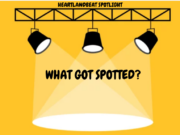Upcoming Events:
June 25: Keep Rural Worksites Strong Mental Health Workshop, 9 a.m.-4 p.m., Seward Family Medical Clinic, $20, RSVP: 877-337-3573
June 25: Irrigation Scheduling to Save Money in Wet Years, Noon-1:30 p.m., Chances R, York, RSVP: 402-694-6174
June 26: SCAL Weed Science Field Day, 8:30 a.m.-1 p.m. (Reg. 8 a.m.), South Central Ag Lab near Clay Center, http://agronomy.unl.edu/fieldday
July 1-2: Tractor Safety Training, Fairgrounds, Weeping Water, (402) 267-2205, https://go.unl.edu/mcyy
July 10: Palmer Amaranth Resistance Field Day, 9 a.m.-1 p.m. (Reg. 8:30 a.m.) Carleton, http://agronomy.unl.edu/palmer
July 10-11: Sustainable Agronomy Conference, Embassy Suites Downtown/Old Market, Omaha
July 15: CSI for Youth: Extension Shadow, jrees2@unl.edu
July 17-19: Solar Design and Installation Hands-on Workshop, Lincoln, NE
July 18-19: Good Farmer to Great Manager, Extension Office, Lincoln
July 19: Communicating with Farmers Under Stress, 9-11 a.m., ENREC (former ARDC) near Mead, RSVP: 402-624-8003
July 24: Science and Ag Family Field Day, 9 a.m.-3 p.m., Haskell Ag Lab, Concord
July 30-31: Good Farmer to Great Manager, Extension Office, Grand Island
Crop Updates: It was nice to see corn greening up and getting some growth this past week! Also on people’s minds is the 45 day post-planting application deadline for RUP dicamba herbicides. The announcement that Risk Management Agency (RMA) adjusted the 2019 final haying and grazing date from Nov. 1 to Sept. 1 for prevented planting this year opened up additional options for our farmers affected by flooding and/or excess rain. An additional option was that “silage, haylage, and bailage should be treated in the same manner as haying and grazing this year. Producers can hay, graze or cut cover crops for silage, haylage or baleage on prevented plant acres on or after September 1 and still maintain eligibility for their full 2019 prevented planting indemnity.”
So how did this change things? Many I talked with, including my family, were originally planning on going with cool season covers like oats planted the first week of August. However, with the ability to harvest a cover crop for forage on Sept. 1, interest increased in utilizing warm season cover crops. For those planning on haying, our forage specialists recommend using millets. The regrowth after haying could then be used for grazing in the late fall/winter. They also said if you’re planning on a mix, don’t add brassicas into whatever you decide to hay as they don’t dry down and tend to create a moldy spot within hay. If you’re looking at grazing only, sudangrass, sorghum sudan, millets, and/or mix with other species are great options. Forage sorghum is a great option for silage.
The other consideration is that some of this ground going into prevent plant already had PRE herbicides applied, making legal options for cover crops that could be grazed or hayed difficult. So Friday was kind of a crazy day for me walking people through options. Honestly, sometimes corn or milo for silage ended up being the most feasible option based on labels. There are also acres of corn and bean fields that were drowned out due to recent flooding and are now considered a “failed crop” by FSA. Herbicides that were applied can make planting covers in those fields difficult too. Some farmers had contracts with seed companies providing free seed for replant. Thus, once again, corn for silage seemed like a feasible and economical option. So, I called Jeff Peterson at Seward Co. FSA to see if this could be an option. He said that it would be a feasible option in 2019 if it was also approved by the person’s crop insurance agent. The first step is to contact your crop insurance agent to discuss your options for prevent plant and/or failed crop. Then go to your FSA office and fill out their form for failed crop and/or prevent plant. Your crop insurance company may require a letter from Extension stating that corn can be used as a forage crop for silage. Again, it will be important to talk with your crop insurance agent and your FSA office about your options for the fields in your counties as I can’t guarantee these are options for every situation.
Tree Problems: The rain and humidity have allowed for numerous fungal diseases on our evergreen and deciduous trees. On deciduous trees, leaves with black/brown spots may be found. We don’t typically recommend fungicides for them and if the diseases get bad enough, the leaves may eventually fall off the trees early. A new flush of leaves typically follows 10-14 days later. On evergreen trees, we’re seeing a number of needle blights and shoot tip blights. We do recommend fungicide applications for them (typically in April or May). However, it is recommended to repeat them every 3-4 weeks when frequent rains occur. Product options for most evergreen diseases include chlorothalonil or a product containing Copper that is labeled for evergreen tree diseases. Bordeaux mixture is often recommended, but I have a hard time finding anyone that carries that.

Sirococcus blight of spruces is one of many diseases being seen this week due to frequent rains and high humidity. Tips of spruce needles appear to be red/brown/purple and dying along with drooping new growth on trees.
Also, be checking trees for bagworms. They’re later this year and just forming new bags. In order to see them, what I do is walk up to the trees (especially cedars or spruces) and just watch the branches for any movement occurring on them. If you’ve had a bagworm problem in the past, what you’ll see is tiny, new brown bags moving as the larvae is building a new bag. I have more info and a video to help visualize what to look for: https://jenreesources.com/2015/06/27/bagworms-in-evergreens/. The best time to spray them is when the bags are less than ½ inch in size. More info and products can be found here: https://go.unl.edu/rgju.


































